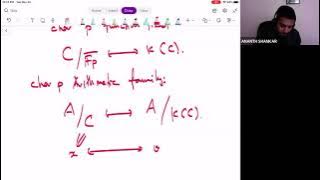
Complex Multiplication: -2+i then -2-i
From playlist Complex Multiplication

Complex Multiplication: 1+2i then 1-2i
From playlist Complex Multiplication

From playlist Complex Multiplication

From playlist Complex Multiplication

ComplexMultiplication 1/3 - i/3
From playlist Complex Multiplication

From playlist Complex Multiplication

Francesc Fité, Sato-Tate groups of abelian varieties of dimension up to 3
VaNTAGe seminar on April 7, 2020 License: CC-BY-NC-SA Closed captions provided by Jun Bo Lau.
From playlist The Sato-Tate conjecture for abelian varieties

Ananth Shankar, Picard ranks of K3 surfaces and the Hecke orbit conjecture
VaNTAGe Seminar, November 23, 2021
From playlist Complex multiplication and reduction of curves and abelian varieties

Stefano Marseglia, Computing isomorphism classes of abelian varieties over finite fields
VaNTAGe Seminar, February 1, 2022 License: CC-BY-NC-SA Links to some of the papers mentioned in this talk: Honda: https://doi.org/10.2969/jmsj/02010083 Tate: https://link.springer.com/article/10.1007/BF01404549 Deligne: https://eudml.org/doc/141987 Hofmann, Sircana: https://arxiv.org/ab
From playlist Curves and abelian varieties over finite fields

Lucia Mocz: A new Northcott property for Faltings height
Abstract: The Faltings height is a useful invariant for addressing questions in arithmetic geometry. In his celebrated proof of the Mordell and Shafarevich conjectures, Faltings shows the Faltings height satisfies a certain Northcott property, which allows him to deduce his finiteness stat
From playlist Algebraic and Complex Geometry

Finite or infinite? One key to algebraic cycles - Burt Totaro
Burt Totaro University of California, Los Angeles; Member, School of Mathematics February 2, 2015 Algebraic cycles are linear combinations of algebraic subvarieties of an algebraic variety. We want to know whether all algebraic subvarieties can be built from finitely many, in a suitable s
From playlist Mathematics

Taylor Dupuy (Nov. 13, 2020): Abelian Varieties Over Finite Fields in the LMFDB
I will talk about things around the LMFDB database of isogeny classes of abelian varieties over finite fields (and maybe even about isomorphism classes). These could include: --"Sato-Ain't" distributions, --weird Tate classes, --Bizzaro Hodge co-levels (and very strange Ax-Katz/Cheval
From playlist Seminar Talks

Tamás Hausel : Toric non-abelian Hodge theory
Find this video and other talks given by worldwide mathematicians on CIRM's Audiovisual Mathematics Library: http://library.cirm-math.fr. And discover all its functionalities: - Chapter markers and keywords to watch the parts of your choice in the video - Videos enriched with abstracts, b
From playlist Algebraic and Complex Geometry

Marc Levine - "The Motivic Fundamental Group"
Research lecture at the Worldwide Center of Mathematics.
From playlist Center of Math Research: the Worldwide Lecture Seminar Series

Jacob Tsimerman, Unlikely intersections and the André-Oort conjecture
VaNTAGe Seminar, December 7, 2021 License: CC-BY-NC-SA
From playlist Complex multiplication and reduction of curves and abelian varieties




